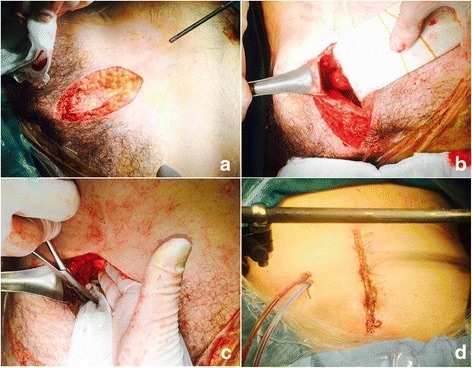Preperitoneal Pelvic Packing (PPP)
Preperitoneal Pelvic Packing (PPP)
David Ray Velez, MD
Table of Contents
Considerations
In General, Rapid Angioembolization is the Preferred Management Rather than PPP for Pelvic Bleeding (Debated)
- PPP Has Decreased Crude Mortality Compared to Angioembolization – However, Studies are Heterogenous with Significant Differences in Populations and Unable to Make a Conclusive Comparison
- 27% of Patients Treated with PPP Did Not Achieve Adequate Hemorrhage Control and Still Required Subsequent Angioembolization
PPP is Contraindicated as the Initial Intervention if Hemodynamically Unstable and FAST is Positive – Requires Laparotomy
Preperitoneal Pelvic Packing (PPP) May Be Preferred if Hemodynamically Unstable and Unable to Tolerate Wait for Angioembolization, if Time for Angioembolization will Be Prolonged, or if Angioembolization is Unavailable
Procedure
Incision/Dissection
- Make a Small 8-10 cm Suprapubic Vertical Incision
- Alternatively Can Make a Pfannenstiel Incision
- Take Caution to Keep Incision Separate from a Midline Laparotomy if Required
- Open the Fascia and Retract the Rectus Muscles Laterally
- Dissect into the Preperitoneal Space (Bleeding Will Often Do Most of the Dissection)
Take Caution to Avoid Entering the Peritoneum – Will Release Tamponade and Make Packing Ineffective
Packing
- Place Three Laparotomy Pads on Either Side of the Bladder
- Large Hematomas May Require More than Six Packs for Effective Compression – Use as Many as Necessary to Pack Tightly
- Ensure Placement Deep into the Pelvis as the Majority of Bleeding Originates in the Posterior Pelvis
Close the Skin to Assist in Tamponade
Strongly Consider Postoperative Angioembolization if There is Evidence for Continued Bleeding with Requirements for Transfusion
Return to the OR Within 24-48 Hours to Remove Packing, Once Resuscitated and Stabilized

Preperitoneal Pelvic Packing 1
References
- Jang JY, Shim H, Jung PY, Kim S, Bae KS. Preperitoneal pelvic packing in patients with hemodynamic instability due to severe pelvic fracture: early experience in a Korean trauma center. Scand J Trauma Resusc Emerg Med. 2016 Jan 13;24:3. (License: CC BY-4.0)
